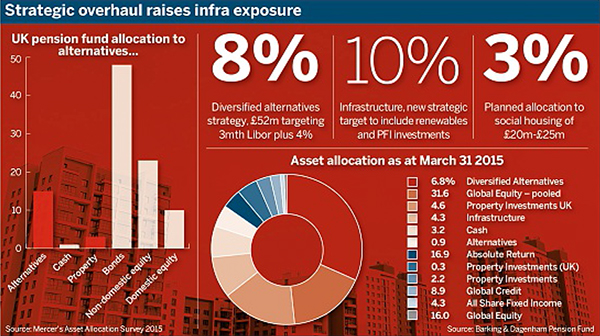Barking & Dagenham channeled 8 per cent of total assets into a diversified alternatives strategy last year in a bid to quell volatility across its portfolio.
Global pension funds were the dominant investors in alternative assets in 2014, holding 33 per cent of the $3.5tn (£2.28tn) assets under management by the top 100 alternative managers, according to consultancy Towers Watson’s 2015 Global Alternatives survey.
Rising interest in alternatives has run in kilter with the bleak outlook in traditional asset classes, with plunging yields in fixed income and spiking volatility across global equity markets.
Building collaboration
David Dickinson, Barking & Dagenham’s group treasury and pensions manager, said the fund is venturing into social housing in collaboration with other local authorities.
Dickinson plans to invest 3 per cent of the fund to provide further protection from market volatility.
“As returns go it will be near the bottom but it will be that asset that probably protects when other things have been quite volatile and potentially losing a bit of money,” he said.
By working with other funds, Dickinson hopes to overcome some of the barriers to entering the social housing market.
Dickinson was positive about the broader movement towards pooling and collaboration but said the whole process needs careful management.
“If you’re trying to force something, what happens if something goes wrong? So you force everyone into a collective investment vehicle, they all migrate to the best-performing managers, those managers start underperforming – it can happen - then who’s to blame?” he said.
“Ultimately, the sole purpose of a pension fund is to pay pensions, we mustn’t divert too far from that.”
The £757.8m Barking & Dagenham fund committed 8 per cent to a diversified alternatives strategy in hedge funds and private equity in 2014. David Dickinson, group treasury and pension manager for the council fund, said the investment has delivered a “steady return” over the past 12 months.
“The idea was to get a similar type of return to equities but with reduced volatility,” he said.
“Hedge funds have generally been quite a good diversifier, they seem to have maintained value when equities have been down by over 10 per cent in the last few months, the hedge funds have provided a positive return.”
Capital and control
Although the fund appointed a manager to run the strategy a year ago, it was seven or eight months before the fund deployed capital to private equity investments due to limited opportunities in the market.
Dickinson said the strategy is a longer-term play between the two asset classes.
“We’re going to stay in the market [and] as the cash flows are called, then move out of some of the more liquid hedge funds and into private equity,” he said.
Barking & Dagenham has pursued a strategic reduction of its equity allocation for the past three years and the addition of a diversified alts strategy builds on its previous work to diversify into property, alternatives and two diversified growth funds which enable ongoing adjustments to its equity exposure.
John Exley, partner in consultancy KPMG’s pension team, said schemes are now assessing a much wider range of asset classes and opportunities beyond traditional equity and bond holdings.
“In all areas we’re looking at a much wider range of opportunities… private equity is just one example of that,” he said.
Targeted approach
Olivier Lebleu, head of international business at Old Mutual Asset Management, said pension funds heading into alternatives were typically playing the “volatility reduction game”.
Schemes looking to move into private equity may encounter a time lag between the commitment and deployment of capital, as well as issues towards the end of a commitment where schemes need to reallocate capital to another fund.
You can be a little bit more nimble and tactical about how you allocate
Olivier Lebleu, OMAM
Lebleu said: “From a liquidity and timing perspective… there would be a fair bit of common sense in using hedge funds, usually with less liquidity restrictions, as the other bucket of alternative exposure.
“You can be a little bit more nimble and tactical about how you allocate.”
Matthew Towsey, senior consultant in liquid alternatives at consultancy Aon Hewitt, said schemes need to target specific hedge fund strategies to maximise diversification benefits and secure the “biggest bang for your buck”.
“Something like a macro strategy has a very low correlation to equities… [they] tend to perform better when markets are volatile,” he said.
“At the other end of the spectrum, if they’re looking for higher return but higher correlation to traditional assets then maybe they’d consider something like equity long/short.”














